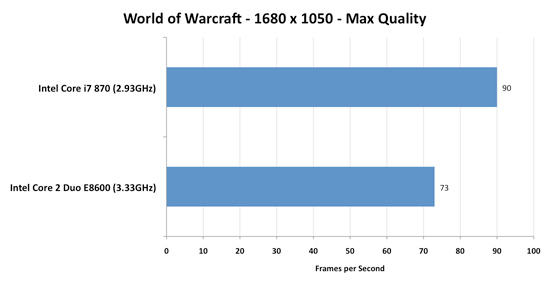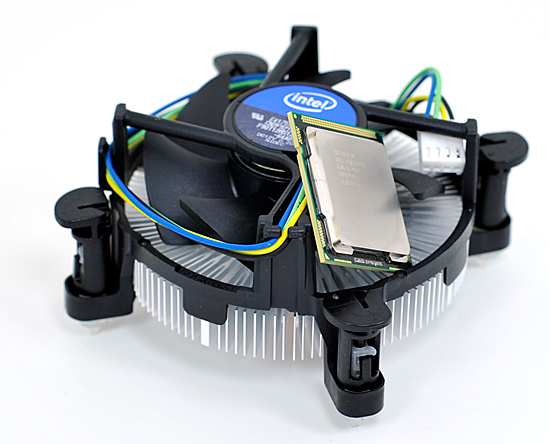Intel's Core i7 870 & i5 750, Lynnfield: Harder, Better, Faster Stronger
by Anand Lal Shimpi on September 8, 2009 12:00 AM EST- Posted in
- CPUs
Lynnfield's Turbo Mode: Up to 17% More Performance
Turbo on Bloomfield (the first Core i7) wasn't all that impressive. If you look back at our Core i7 article from last year you'll see that it's responsible for a 2 - 5% increase in performance depending on the application. All Bloomfield desktop CPUs had 130W TDPs, so each individual core had a bit more breathing room for how fast it could run. Lynnfield brings the TDP down around 27%, meaning each core gets less TDP to work with (the lower the TDP, the greater potential there is for turbo). That combined with almost a full year of improving yields on Nehalem means that Intel can be much more aggressive with Turbo on Lynnfield.
| SYSMark 2007: Overall | Dawn of War II | Sacred 2 | World of Warcraft | |
| Intel Core i7 870 Turbo Disabled | 206 | 74.3 fps | 84.8 fps | 60.6 fps |
| Intel Core i7 870 Turbo Enabled | 233 | 81.0 fps | 97.4 fps | 70.7 fps |
| % Increase from Turbo | 13.1% | 9.0% | 14.9% | 16.7% |
Turbo on Lynnfield can yield up to an extra 17% performance depending on the application. The biggest gains will be when running one or two threads as you can see from the table below:
| Max Speed | Stock | 4 Cores Active | 3 Cores Active | 2 Cores Active | 1 Core Active |
| Intel Core i7 870 | 2.93GHz | 3.20GHz | 3.20GHz | 3.46GHz | 3.60GHz |
| Intel Core i7 860 | 2.80GHz | 2.93GHz | 2.93GHz | 3.33GHz | 3.46GHz |
| Intel Core i5 750 | 2.66GHz | 2.80GHz | 2.80GHz | 3.20GHz | 3.20GHz |
If Intel had Turbo mode back when dual-cores first started shipping we would've never had the whole single vs. dual core debate. If you're running a single thread, this 774M transistor beast will turn off three of its cores and run its single active core at up to 3.6GHz. That's faster than the fastest Core 2 Duo on the market today.

WoW doesn't stress more than 2 cores, Turbo mode helps ensure the i7 870 is faster than Intel's fastest dual-core CPU
It's more than just individual application performance however, Lynnfield's turbo modes can kick in when just interacting with the OS or an application. Single threads, regardless of nature, can now execute at 3.6GHz instead of 2.93GHz. It's the epitomy of Intel's hurry up and get idle philosophy.
The ultimate goal is to always deliver the best performance regardless of how threaded (or not) the workload is. Buying more cores shouldn't get you lower clock speeds, just more flexibility. The top end Lynnfield is like buying a 3.46GHz dual-core processor that can also run well threaded code at 2.93GHz.
Take this one step further and imagine what happens when you have a CPU/GPU on the same package or better yet, on the same die. Need more GPU power? Underclock the CPU cores, need more CPU power? Turn off half the GPU cores. It's always availble, real-time-configurable processing power. That's the goal and Lynnfield is the first real step in that direction.
Speed Limits: Things That Will Keep Turbo Mode from Working
As awesome as it is, Turbo doesn't work 100% of the time, its usefulness varies on a number of factors including the instruction mix of active threads and processor cooling.
The actual instructions being executed by each core will determine the amount of current drawn and total TDP of the processor. For example, video encoding uses a lot of SSE instructions which in turn keep the SSE units busy on the chip; the front end remains idle and is clock gated, so power is saved there. The resulting power savings are translated into higher clock frequency. Intel tells us that video encoding should see the maximum improvement of two bins with all four cores active.
Floating point code stresses both the front end and back end of the pipe, here we should expect to see only a 133MHz increase from turbo mode if any at all. In short, you can't simply look at whether an app uses one, two or more threads. It's what the app does that matters.
There's also the issue of background threads running in the OS. Although your foreground app may only use a single thread, there are usually dozens (if not hundreds) of active threads on your system at any time. Just a few of those being scheduled on sleeping cores will wake them up and limit your max turbo frequency (Windows 7 is allegedly better at not doing this).
You can't really control the instruction mix of the apps you run or how well they're threaded, but this last point you can control: cooling. The sort-of trump all feature that you have to respect is Intel's thermal throttling. If the CPU ever gets too hot, it will automatically reduce its clock speed in order to avoid damaging the processor; this includes a clock speed increase due to turbo mode.

Lynnfield and its retail cooler
The retail cooler that ships with the Core i7 is tiny and while it's able to remove heat well enough to allow the chip to turbo up, we've seen instances where it doesn't turbo as well due to cooling issues. Just like we recommended in the Bloomfield days, an aftermarket cooler may suit you well.
Lynnfield: Made for Windows 7 (or vice versa)
Core Parking is a feature included in Windows 7 and enabled on any multi-socket machine or any system with Hyper Threading enabled (e.g. Pentium 4, Atom, Core i7). The feature looks at the performance penalty from migrating a thread from one core to another; if the fall looks too dangerous, Windows 7 won't jump - the thread will stay parked on that core.
What this fixes are a number of the situations where enabling Hyper Threading will reduce performance thanks to Windows moving a thread from a physical core to a logical core. This also helps multi-socket systems where moving a thread from one core to the next might mean moving it (and all of its data) from one memory controller to another one on an adjacent socket.
Core Parking can't help an application that manually assigns affinity to a core. We've still seen situations where HT reduces performance under Windows 7 for example with AutoCAD 2010 and World of Warcraft.
With support in the OS however, developers should have no reason to assign affinity in software - the OS is now smart enough to properly handle multi-socket and HT enabled machines.










343 Comments
View All Comments
goinginstyle - Tuesday, September 8, 2009 - link
Really? SuperPi, WPrime, Everest, 3Dmarks and LN2 overclocking defines a better review? How does any of that correlate into real world applications and what 99% of people use their computers for on a daily basis. I counted a lot more than three tests in the AT review, go spam elsewhere.C'DaleRider - Tuesday, September 8, 2009 - link
Really. All I play is SuperPi, Everest and 3DMarks....oh, and Furmark and OCCT.Who would ever use their computer to encode video, run Excel spreadsheets, play games like Far Cry or Crysis or Left For Dead, or actually use any other real world application?
Don't you know? Real elite computer users just bench synthetic crap, over and over, for hours and hours, and scoff at anyone who dares do anything productive with their computer.
/sarcasm
geok1ng - Tuesday, September 8, 2009 - link
I am not pleased by the news; i5 needs more juice for overcloking. Thats terrible: my E8600 is still on top: it runs at 4.0Ghz with 1.16v on a watercooled setup with 4x120mm fans at 1600rpm. we are talking less than 30dB of noise and less than 55w of power consumption. At 1.25v my E8600 reaches 4.25Ghz and would go a little further if wasnt for the 4 sticks of ram burning the NB. no reason to exchange systems before the 32nm parts arrive. The ability to achieve high clocks with low voltages is crucial for a good system: not only will it consume less power, but it will also be quieter, and that is a point for choosing sub-65w dual-cores in gaming rigs.papapapapapapapababy - Tuesday, September 8, 2009 - link
honestly... i lol at all the core i7 core i5 "GAMERS"( and their punny 23 lcd with shitty TN panels) also LGA1366? LGA1156? and 285$ for a shitty motherboard? XD I have a better proposition for you INTEL. how about u SUCK MY BALLS XD. MKAY? the story: my old man needed a gaming setup ( mostly simracing) So i bought the cheapest E7200 i could find (oc3.2GHZ), 4gb of ram, the cheapest intel mobo i could find -g31- ( not even pcie2) and gave him my 4770 ... the price? ridiculously cheap... almost nothing. and with all that extra money i saved i got this > a nice 42" HDTV with a perfect s-ips panel and low 1366 X 768 resolution, and a g25 wheel.
btw, the framerates? i never, ever drop below 30fps. ALWAYS 60FPS NO MATTER WHAT, ( with nice 8xAA) XD so the best gaming cpu? the cheapest !
erple2 - Tuesday, September 8, 2009 - link
Interesting. Which 42" LCD TV did you get that has a S-IPS panel? Also, a 23" panel at about 3 feet looks bigger than a 42" screen at 6 feet.papapapapapapapababy - Tuesday, September 8, 2009 - link
LG. btw a 23" TN lcd looks like shit no matter how you look at it.C'DaleRider - Tuesday, September 8, 2009 - link
My, aren't you special?papapapapapapapababy - Tuesday, September 8, 2009 - link
yes, i know! btw enjoy your small screen gaming, mr sheep XDchrnochime - Tuesday, September 8, 2009 - link
I'd say the same about that barely big enough 42" LCD, but then again why bother...papapapapapapapababy - Tuesday, September 8, 2009 - link
my bad i meant this > E7300 3.2ghz (+ a cheap 24$ modded heatpipe cooler... 14 dba XD)